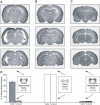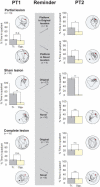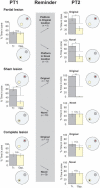Forgetting, reminding, and remembering: the retrieval of lost spatial memory
- PMID: 15314651
- PMCID: PMC509297
- DOI: 10.1371/journal.pbio.0020225
Forgetting, reminding, and remembering: the retrieval of lost spatial memory
Abstract
Retrograde amnesia can occur after brain damage because this disrupts sites of storage, interrupts memory consolidation, or interferes with memory retrieval. While the retrieval failure account has been considered in several animal studies, recent work has focused mainly on memory consolidation, and the neural mechanisms responsible for reactivating memory from stored traces remain poorly understood. We now describe a new retrieval phenomenon in which rats' memory for a spatial location in a watermaze was first weakened by partial lesions of the hippocampus to a level at which it could not be detected. The animals were then reminded by the provision of incomplete and potentially misleading information-an escape platform in a novel location. Paradoxically, both incorrect and correct place information reactivated dormant memory traces equally, such that the previously trained spatial memory was now expressed. It was also established that the reminding procedure could not itself generate new learning in either the original environment, or in a new training situation. The key finding is the development of a protocol that definitively distinguishes reminding from new place learning and thereby reveals that a failure of memory during watermaze testing can arise, at least in part, from a disruption of memory retrieval.
Conflict of interest statement
The authors have declared that no conflicts of interest exist.
Figures






References
-
- Bannerman DM, Good MA, Butcher SP, Ramsay M, Morris RGM. Distinct components of spatial learning revealed by prior training and NMDA receptor blockade. Nature. 1995;378:182–186. - PubMed
-
- Cherkin A. Retrograde amnesia in the chick: Resistance to the reminder effect. Physiol Behav. 1972;8:949–955.
-
- Concannon JT, Carr C. Pre-test epinephrine injections reverse DDC-induced retrograde amnesia. Physiol Behav. 1982;9:443–448. - PubMed
-
- Davis HP, Squire LR. Protein synthesis and memory: A review. Psychol Bull. 1984;96:518–559. - PubMed
-
- de Hoz L, Knox J, Morris RGM. Longitudinal axis of the hippocampus: Both septal and temporal poles of the hippocampus support watermaze spatial learning depending on the training protocol. Hippocampus. 2003;13:587–603. - PubMed
Publication types
MeSH terms
LinkOut - more resources
Full Text Sources
Other Literature Sources
Medical

